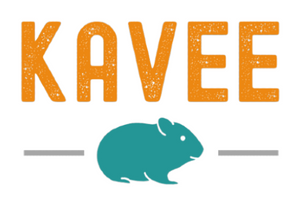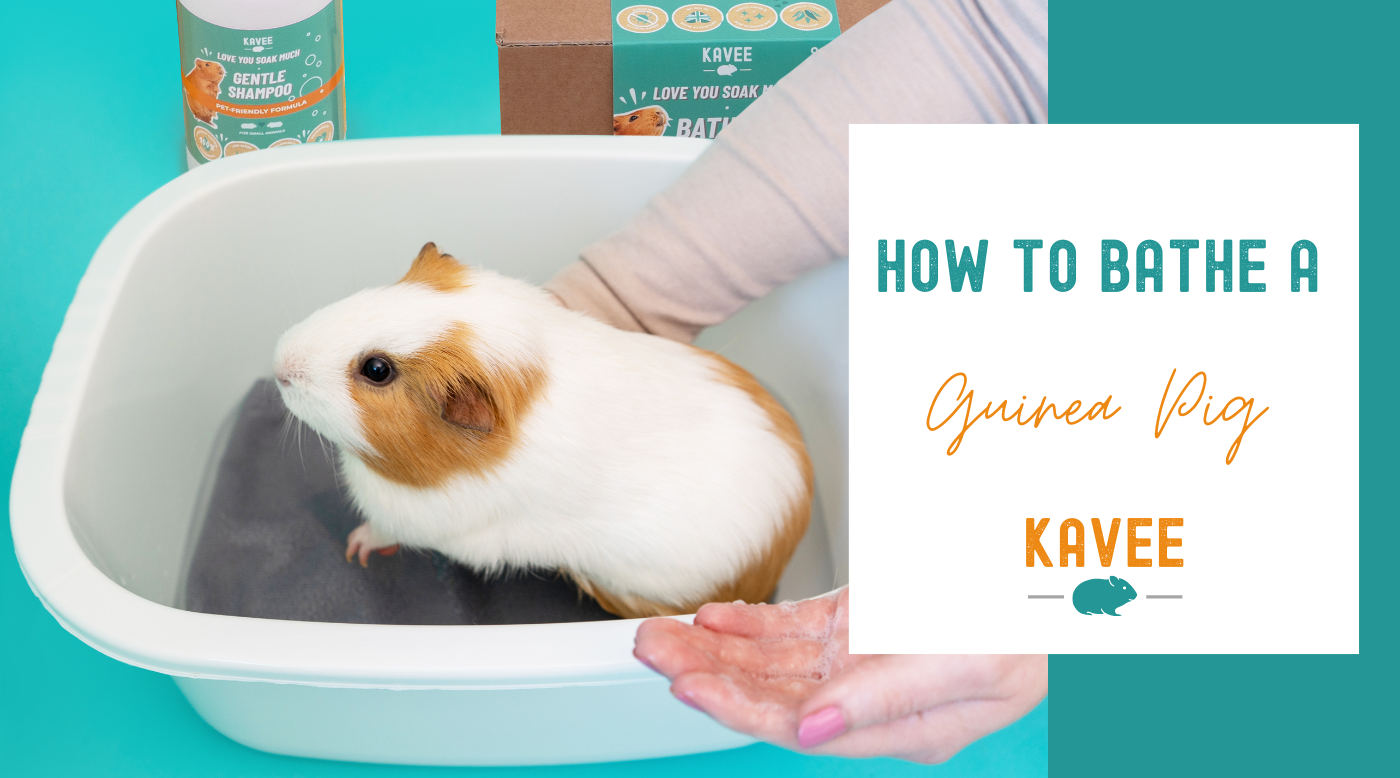Guinea pigs are clean pets… most of the time. The cute critters spend a lot of time looking after their fur and overall appearances, but they also poop a lot - as every piggy parent can tell you. No matter how hard the floofs try, they sometimes get messy. And that’s when cavy carers start to wonder, ‘can you bathe guinea pigs'?
Generally, our furry friends only need the odd guinea pig bath every couple of months. Bathing them too often could actually have negative effects on your floofs. So how often should you bathe a guinea pig? What kinds of shampoo can you use? And how can you make it a stress-free experience for them?
Let us take you through the steps of how to bathe a guinea pig safely!

How often should I bathe my guinea pig?
Guinea pigs are great at taking care of their personal hygiene, so most of the time, they don’t really need to have a bath. In fact, we recommend you only bathe guinea pigs 2 to 4 times a year, mostly when they get really smelly or soggy.
Piggies have sensitive skin and bathing them puts their skin at risk of drying out. A wash strips their fur and skin of natural protective oils which makes dry, cracked, and even infected skin a real possibility.
To keep your sweet floofs’ skin shiny and healthy, it’s best to limit the amount of times they’re in water. The exception to this rule are older guinea pigs and those with special care needs. Also, if a vet recommends a guinea pig bath, it’s important to follow their advice.

When should I give my guinea pig a bath?
If your guinea pig starts to smell unpleasantly, or their bottom looks soggy, it may be time for a bath. Long-haired guinea pigs are particularly prone to soggy bottoms, so it’s worth checking (and cutting) their long locks regularly.
Other reasons for a wash can include skin or fur treatment, for example when a piggy carries fleas or mites. Some cavy carers prefer spot-on treatments over baths, so it’s a good idea to check your options. Your cavy-savvy vet can help you find the right treatment for your floofs and explain how to apply it properly.
Senior piggies are also more likely to get their fur soiled. Older pigs tend to sleep more, so they sometimes stay in one place long enough to get themselves a little messy. Plus, some struggle with impaction and really benefit from a gentle bath. If you notice your senior sweeties being particularly messy, it’s a good idea to speak to a vet.
What do I need to bathe my guinea pig?
Here's everything you're going to need to give your guinea pig a bath:
- Sink or wash basin with a flat surface
- Non-slip base, like a towel
- Guinea pig-safe shampoo
- Microfiber towel
- Bath thermometer (optional)
- Your piggy’s favorite snack
Once you’ve got all items in one place, follow our simple step-by-step guide to a safe and stress-free guinea pig bath!
It’s easiest to wash your piggy with an extra pair of hands nearby, so one person is supervising the piggy while the other focuses on washing them.

A word of warning on Shampoo
Guinea pig skin is very sensitive, so using regular human shampoo, soap, or even shampoo for other pets puts their shiny skin and coat at risk. To be on the safe side, only choose a small pet shampoo that’s specifically made for guinea pigs. Even better if it’s gentle enough for skinny pigs!
Although you may read about alternative shampoos you can use on your pig, like certain kinds of dish soap or dandruff shampoo, it’s best for your floofs’ wellbeing to be extra safe in your shampoo choice.
How to bathe a guinea pig
Step 1: Prepare the guinea pig bath
Once you’ve chosen a sink or basin for the bath, place a non-slip base inside it. You can simply pop a towel at the bottom, as this will stop your furry friend from slipping on the smooth surface, and it’ll make the bath much less stressful for them.
Next, add an inch or two of lukewarm water to the sink/basin, this will be plenty since you’ll mainly wash their bottom area. You can check the temperature by running it over the sensitive skin on your wrist. If it feels hot to you, it’ll also feel hot to your piggy. Make sure the bath is between 90°F and 95°F (32°C and 35°C) - use a child-safe bath thermometer if you're not sure.
Remember to set up the other items nearby, like the shampoo, snacks, and microfiber towel, so it’ll be easy to go through each step of your guinea pig bath.

Step 2: Add your guinea pig
Now that everything’s set up and ready to go, you can add your guinea pig to the basin. Create a calm, quiet environment, especially if it’s their first bath, with plenty of snack breaks.
Gently place them in the water, and give them the time to adjust. Your guinea pig may not enjoy being in the water, and could even try to hop out, so be prepared to watch them carefully.

Step 3: Wet their fur
When your piggy’s settled and calm in the water, use one hand to scoop water over your guinea pig’s bottom. Throughout the entire wash, you’ll want to avoid getting any area above their stomach wet. Normally, only your guinea pig’s underside gets dirty, so you don’t have to worry about washing their back or sides.
It’s important that the water doesn’t get near their eyes, ears, nose, or mouth at any point. Your piggy could breathe in water and develop breathing issues, as well as an infection. Stick to their underside and bottom to keep them safe!

Step 4: Shampooing your piggy
Follow the same path you’ve used to wet your floof’s fur for the shampoo. Add the product to your hands and massage it gently into your piggy’s lower body until you’ve got a nice lather. By moving in slow, careful circles, you’ll give your piggy a nice massage as well as a much-needed bath.
If you want to wash their belly, you can place their front paws on one hand and lift it slightly, making sure the back legs stay firmly on the ground. Then use your other hand to gently wash that area.

Step 5: Rinsing out the shampoo
When you feel that your guinea pig is sufficiently shampooed, you’ll want to get rid of the soap with a rinse. You could place your pet in a safe spot, like a carrier, while you change the water. Then you can place them back inside the sink or basin and rinse the shampooed areas carefully.
If you struggle to change the water while your pig is waiting, you can try to rinse their coat in the water you originally used. But it’s important to get rid of any traces of the shampoo, so fresh water works best.

Step 6: Dry your piggy
Time to dry! For many piggies, this is the favorite part of their guinea pig bath. If you have your microfiber towel ready, lift your guinea pig out of the water and onto the comfy towel straight away. Remember that they may try to escape, so it’s best to place the towel on a flat surface they can’t jump out of and keep a close eye on your piggy.
You can wrap them fully in their towel, with their head poking out for fresh air. If you gently dab their wet fur and keep them on your lap for extra warmth, they’ll be completely dry in a few minutes. Microfiber towels are particularly great to dry your piggy’s fur quickly.
While you can use hair dryers on the lowest setting to dry your piggies, it’s easy to overheat or burn them in the process. By towel-drying your cavy fully after their bath, you’re making sure they don’t get cold, as a wet piggy can catch a cold easily.

Step 6: Give them a snack
After all the excitement, your precious piggy deserves a treat while they keep on drying. What a day!

Now you know how to bathe a guinea pig - well done! And if you're still unsure, check out this video from pig-expert Tara from the Kavee Rescue on bathing guinea pigs:
From bathing to grooming guinea pigs
Some piggy parents might take this as an opportunity to get their piggies’ fur, skin, and nails in tip-top shape. After the wash, they may cut their floof’s nails and trim their hair. Some even choose to follow the bath with a good brush.
It’s appealing to get all grooming done in one go, but remember that your piggy is probably stressed from the guinea pig bath alone. If your pet seems distressed or scared at any point, it’s best to try grooming them another day. After all, we want our floofs to enjoy the process, right?

Conclusion
Unlike their humans, guinea pigs don’t need regular baths. If you’ve got the right equipment and shampoo, you can bathe your guinea pig every three to four months if they need it. The best time to do so is when they're particularly smelly and soggy.
Just make sure you have a pet-safe shampoo ready for gentle cleaning, and a comfy microfibre towel to dry them out afterwards. Happy piggy bath time!



